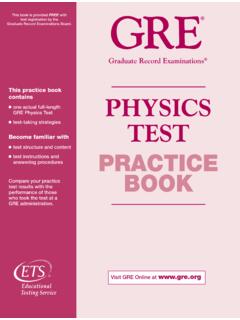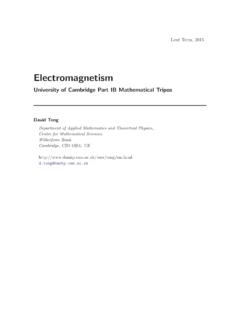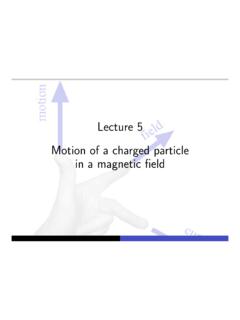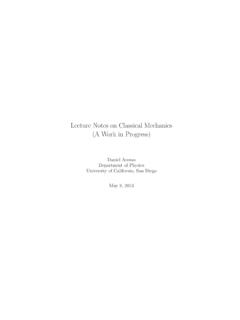Transcription of QUANTUM YANG–MILLS THEORY The Physics of Gauge Theory
1 QUANTUM YANG MILLS THEORYARTHUR JAFFE AND EDWARD Physics of Gauge TheorySince the early part of the 20th century, it has been understood that the descrip-tion of nature at the subatomic scale requires QUANTUM mechanics. In QUANTUM me-chanics, the position and velocity of a particle are noncommuting operators actingon a Hilbert space, and classical notions such as the trajectory of a particle donot QUANTUM mechanics of particles is not the whole story. In 19th and early20th century Physics , many aspects of nature were described in terms of fields theelectric and magnetic fields that enter in Maxwell s equations, and the gravitationalfield governed by Einstein s equations. Since fields interact with particles, it be-came clear by the late 1920s that an internally coherent account of nature mustincorporate QUANTUM concepts for fields as well as for doing this, quantities such as the components of the electric field at differ-ent points in space-time become non-commuting operators.
2 When one attempts toconstruct a Hilbert space on which these operators act, one finds many distinction between fields and particles breaks down, since the Hilbert spaceof a QUANTUM field is constructed in terms of particle-like excitations. Conventionalparticles, such as electrons, are reinterpreted as states of the quantized field. Inthe process, one finds the prediction of antimatter ; for every particle, there mustbe a corresponding antiparticle, with the same mass and opposite electric after Dirac predicted this on the basis of QUANTUM field THEORY , the positron or oppositely charged antiparticle of the electron was discovered in cos-mic most important QUANTUM Field Theories (QFTs) for describing elementaryparticle Physics are Gauge theories. The classical example of a Gauge THEORY isMaxwell s THEORY of electromagnetism. For electromagnetism the Gauge symmetrygroup is the abelian groupU(1).
3 IfAdenotes theU(1) Gauge connection, locallya one-form on space-time, then the curvature or electromagnetic field tensor is thetwo-formF=dA, and Maxwell s equations in the absence of charges and currentsread 0 =dF=d F. Here denotes the Hodge duality operator; indeed, Hodgeintroduced his celebrated THEORY of harmonic forms as a generalization of the solu-tions to Maxwell s equations. Maxwell s equations describe large-scale electric andmagnetic fields and also as Maxwell discovered the propagation of light waves,at a characteristic velocity, the speed of idea of a Gauge THEORY evolved from the work of Hermann Weyl. One canfind in [34] an interesting discussion of the history of Gauge symmetry and thediscovery of Yang Mills THEORY [50], also known as non-abelian Gauge THEORY . At the classical level one replaces the Gauge groupU(1) of electromagnetism by acompact Gauge groupG.
4 The definition of the curvature arising from the connection12 ARTHUR JAFFE AND EDWARD WITTEN must be modified toF=dA+A A, and Maxwell s equations are replaced bythe Yang Mills equations, 0 =dAF=dA F, wheredAis the Gauge -covariantextension of the exterior classical equations can be derived as variational equations from the Yang Mills Lagrangian(1)L=14g2 TrF F,where Tr denotes an invariant quadratic form on the Lie algebra ofG. The Yang Mills equations are nonlinear in contrast to the Maxwell equations. Like theEinstein equations for the gravitational field, only a few exact solutions of theclassical equation are known. But the Yang Mills equations have certain propertiesin common with the Maxwell equations: In particular they provide the classicaldescription of massless waves that travel at the speed of the 1950s, when Yang Mills THEORY was discovered, it was already known thatthe QUANTUM version of Maxwell THEORY known as QUANTUM Electrodynamics orQED gives an extremely accurate account of electromagnetic fields and forces.
5 Infact, QED improved the accuracy for certain earlier QUANTUM THEORY predictions byseveral orders of magnitude, as well as predicting new splittings of energy it was natural to inquire whether non-abelian Gauge THEORY described otherforces in nature, notably the weak force (responsible among other things for certainforms of radioactivity) and the strong or nuclear force (responsible among otherthings for the binding of protons and neutrons into nuclei). The massless natureof classical Yang Mills waves was a serious obstacle to applying Yang Mills theoryto the other forces, for the weak and nuclear forces are short range and many ofthe particles are massive. Hence these phenomena did not appear to be associatedwith long-range fields describing massless the 1960s and 1970s, physicists overcame these obstacles to the physical in-terpretation of non-abelian Gauge THEORY .
6 In the case of the weak force, this wasaccomplished by the Glashow Salam Weinberg electroweak THEORY [47, 40] withgauge groupH=SU(2) U(1). By elaborating the THEORY with an additional Higgs field, one avoided the massless nature of classical Yang Mills waves. TheHiggs field transforms in a two-dimensional representation ofH; its non-zero andapproximately constant value in the vacuum state reduces the structure group fromHto aU(1) subgroup (diagonally embedded inSU(2) U(1)). This THEORY de-scribes both the electromagnetic and weak forces, in a more or less unified way;because of the reduction of the structure group toU(1), the long-range fields arethose of electromagnetism only, in accord with what we see in solution to the problem of massless Yang Mills fields for the strong in-teractions has a completely different nature. That solution did not come fromadding fields to Yang Mills THEORY , but by discovering a remarkable property of thequantum Yang Mills THEORY itself, that is, of the QUANTUM THEORY whose classicalLagrangian has been given in (1).
7 This property is called asymptotic freedom [21, 38]. Roughly this means that at short distances the field displays quantumbehavior very similar to its classical behavior; yet at long distances the classicaltheory is no longer a good guide to the QUANTUM behavior of the freedom, together with other experimental and theoretical discov-eries made in the 1960s and 1970s, made it possible to describe the nuclear forceQUANTUM YANG MILLS THEORY3by a non-abelian Gauge THEORY in which the Gauge group isG=SU(3). The ad-ditional fields describe, at the classical level, quarks, which are spin 1/2 objectssomewhat analogous to the electron, but transforming in the fundamental repre-sentation ofSU(3). The non-abelian Gauge THEORY of the strong force is calledQuantum Chromodynamics (QCD).The use of QCD to describe the strong force was motivated by a whole series ofexperimental and theoretical discoveries made in the 1960s and 1970s, involving thesymmetries and high-energy behavior of the strong interactions.
8 But classical non-abelian Gauge THEORY is very different from the observed world of strong interactions;for QCD to describe the strong force successfully, it must have at the quantumlevel the following three properties, each of which is dramatically different from thebehavior of the classical THEORY :(1) It must have a mass gap; namely there must be some constant >0such that every excitation of the vacuum has energy at least .(2) It must have quark confinement, that is, even though the THEORY is de-scribed in terms of elementary fields, such as the quark fields, that transformnon-trivially underSU(3), the physical particle states such as the proton,neutron, and pion areSU(3)-invariant.(3) It must have chiral symmetry breaking, which means that the vacuum ispotentially invariant (in the limit, that the quark-bare masses vanish) onlyunder a certain subgroup of the full symmetry group that acts on the first point is necessary to explain why the nuclear force is strong but short-ranged; the second is needed to explain why we never see individual quarks; andthe third is needed to account for the current algebra THEORY of soft pions thatwas developed in the experiment since QCD has numerous successes in confrontation withexperiment and computer simulations, see for example [8], carried out since thelate 1970s, have given strong encouragement that QCD does have the propertiescited above.
9 These properties can be seen, to some extent, in theoretical calcula-tions carried out in a variety of highly oversimplified models (like strongly coupledlattice Gauge THEORY , see, for example, [48]). But they are not fully understoodtheoretically; there does not exist a convincing, whether or not mathematicallycomplete, theoretical computation demonstrating any of the three properties inQCD, as opposed to a severely simplified truncation of for Mathematical UnderstandingIn surveying the Physics of Gauge theories in the last section, we considered bothclassical properties such as the Higgs mechanism for the electroweak THEORY and QUANTUM properties that do not have classical analogs like the mass gap andconfinement for QCD. Classical properties of Gauge THEORY are within the reach ofestablished mathematical methods, and indeed classical non-abelian Gauge theoryhas played a very important role in mathematics in the last twenty years, especiallyin the study of three- and four-dimensional manifolds.
10 On the other hand, one doesnot yet have a mathematically complete example of a QUANTUM Gauge THEORY infour-dimensional space-time, nor even a precise definition of QUANTUM Gauge theoryin four dimensions. Will this change in the 21st century? We hope so!4 ARTHUR JAFFE AND EDWARD WITTENAt times, mathematical structures of importance have first appeared in physicsbefore their mathematical importance was fully recognized. This happened with thediscovery of calculus, which was needed to develop Newtonian mechanics, with func-tional analysis and group representation THEORY , topics whose importance becameclearer with QUANTUM mechanics, and even with the study of Riemannian geometry,whose development was greatly intensified once it became clear, through Einstein sinvention of General Relativity to describe gravity, that this subject plays a role inthe description of nature. These areas of mathematics became generally accessibleonly after a considerable time, over which the ideas were digested, simplified, andintegrated into the general mathematical Field THEORY (QFT) became increasingly central in Physics throughoutthe 20th century.










